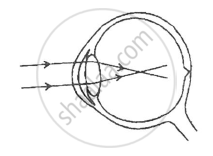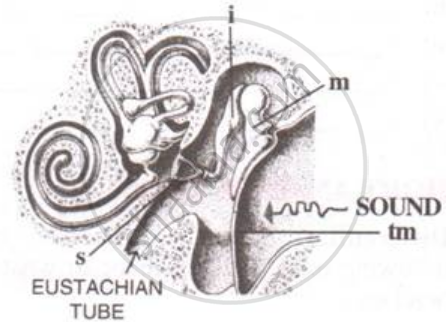Advertisements
Advertisements
Question
Eye : Optic nerve : : Ear : ___________
Solution
Eye : Optic nerve : : Ear : Auditory nerve
APPEARS IN
RELATED QUESTIONS
Explain how the human ear works.
Which part of our body helps us in maintaining the body balance?
Mention the exact location of the Eustachian tube
State the exact location of the Ciliary body
Given below is a diagram depicting a defect of the human eye, study the same and then answer the questions that follow:

(i) Name the defect shown in the diagram.
(ii) What are the two possible that cause this defect?
(iii) Name the type of lens used to correct this defect.
(iv) With the help of a diagram show how the defect shown above is rectified using a suitable lens.
fill in the blanks with suitable functions: Ciliary body and __________.
What is the function of ear ossicles?
Differentiate between the Rods and Cones of Retina (Type of pigment)
With reference to the human ear, answer the question that follow:
Give the technical term for the structure found in the inner ear.
The figure below is the sectional view of a part of the skull showing s sense organ:

Name the sense organ.
Mention the exact location of the following :
Incus
Give the main function of the following:
Cochlea
Write whether the following is true or false:
The part of the ear associated with balance is the cochlea.
The figure below is the sectional view of a part of the skull showing a sense organ:

Name the part labeled 'tm'. What is its function?
Given below is the diagram of the human ear. Study the diagram and then answer the questions that follow:

(i) What role does the eardrum play in hearing?
(ii) What common term is given to the parts labeled A, B, and E?
(iii) Would there be any difference if these three parts mentioned in (ii) above were replaced by one by one? Why?
(iv) Give the biological term for the parts labeled C and D.
(v) Name the fluid which fills the parts mentioned in (iv) above.
(vi) State the functions of the ear.
The part of the ear that collects the sound from the surroundings is ______.
Assertion: Human beings Cannot hear infrasonic sounds.
Reason: Sound with a frequency less than 20 Hz is called infrasonic sound.
Categorise the following parts under (i) external, (ii) middle and (iii) internal ear.
Ear drum, hammer, pinna, cochlea, anvil, stirrup, eustachian tube, tympanum, oval window, semi-circular canals.
State the functions of the following:
Auditory nerve
Which of the following structures equalises the air pressure on either side of the tympanum?
